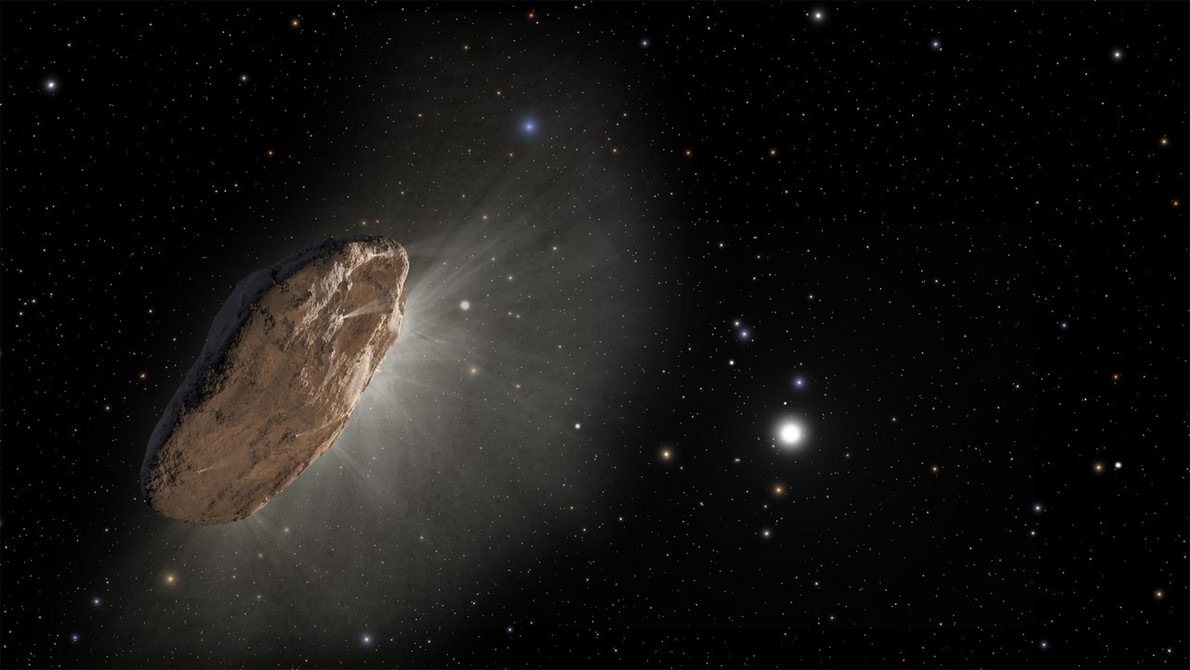Was it alien space junk? A wandering interstellar asteroid? Or a
weird comet from another sun?
Ever since 2017, when astronomers in Hawaii discovered an object
they called Oumuamua (Hawaiian for “scout”) zipping through the solar system,
they have been arguing about what it was.
اضافة اعلان
Telescopes saw only a tumbling dot that was already on its way
back out into the interstellar dark. Astronomers deduced that it was reddish,
cigar- or pancake-shaped, and perhaps a few hundred meters long. To date, all
the comets observed in our solar system have ranged from around a 0.8km to
hundreds of kilometers across.
Initially Oumuamua was pegged as an asteroid, as it exhibited
none of the sizzle and flash typical of comets. (Comets are basically dirty
snowballs; when warmed by sunlight, they emit jets of steam, carbon dioxide and
dust, which create bright tails or comas.) There was no evidence of gas or dust
around the object, and radio telescopes heard nothing when pointed at it.
But further analysis revealed that something was making Oumuamua
speed up as it exited the solar system, leaving scientists with a delicious
puzzle.
Now, two astronomers have found what they call “a surprisingly
simple explanation” for Oumuamua’s behavior: The object was a comet after all,
propelled by minuscule amounts of hydrogen gas spurting from an icy core.
 An artist's
illustrative concept provided by NASA shows the intertellar object called
Oumuamua.
An artist's
illustrative concept provided by NASA shows the intertellar object called
Oumuamua.
“We show that this mechanism can explain many of Oumuamua’s
peculiar properties without fine-tuning,” Jennifer Bergner, an astrochemist at
the University of California, Berkeley, and Darryl Z. Seligman, of Cornell
University, wrote in a paper published last week in Nature. “This provides
further support that Oumuamua originated as a planetesimal relic broadly
similar to solar system comets.”
In a statement issued by the University of California, Berkeley,
Seligman said: “What’s beautiful about Jenny’s idea is that it’s exactly what
should happen to interstellar comets. We had all these stupid ideas, like
hydrogen icebergs and other crazy things, and it’s just the most generic
explanation.”
In an email, Karen Meech, a comet expert at the University of
Hawaii Institute for Astronomy who has studied Oumuamua extensively, called the
paper “a very interesting explanation.”
“I’m not willing to say it ‘solves’ things — the smoking gun
there would be to have detected hydrogen spectroscopically,” she added. “But it
is very plausible, and if another object is discovered that looks like
Oumuamua, then all these models and explanations provide a lot of guidance for
the observations. I’m amazed at how much work has gone into explaining this one
object — a lot of creative effort has gone into getting the best understanding
possible.”
Now, two astronomers have found what they call “a surprisingly simple explanation” for Oumuamua’s behavior: The object was a comet after all, propelled by minuscule amounts of hydrogen gas spurting from an icy core.
The controversy is not likely to evaporate anytime soon. Avi
Loeb, an astronomer at Harvard who has proposed that Oumuamua could have been a
light-sail or some other alien artifact, was quick to take issue with the new
paper.
“The authors of the new paper claim that it was a water ice
comet even though we did not see the cometary tail,” Loeb said in an email. He
added, “This is like saying an elephant is a zebra without stripes.”
Bergner and Seligman began collaborating on a solution to the
Oumuamua mystery as postdoctoral fellows at the University of Chicago.
“We had never seen a comet in the solar system that didn’t have
a dust coma,” Seligman said. “So the nongravitational acceleration really was
weird.”
Bergner, an expert on the chemistry of ice in outer space,
wondered if molecular hydrogen gas, the lightest, most abundant and most
volatile element in the universe, could be responsible for propelling the
comet. But where would the gas have come from?
She found that lab experiments done as far back as the 1970s
showed that when ice is struck by high-energy particles, its molecules can
break apart, leaving tiny bubbles of hydrogen gas trapped several meters deep
in the ice.
“A comet traveling through the interstellar medium basically is
getting cooked by cosmic radiation, forming hydrogen as a result,” Bergner said
in a statement issued by the University of California, Berkeley.
She added in an email: “Water ice in its amorphous form has a
fluffy structure containing pockets where other volatile molecules can be
trapped. As the ice is warmed, it rearranges to a more stable and compact
structure.” This process, she said, “leads to the collapse of these pockets and
the formation of channels within the ice, through which trapped gas can
escape.”
For a normal-size comet, this release of gas would have a
negligible effect, Bergner said. “But because Oumuamua was so small, we think
that it actually produced sufficient force to power this acceleration.”
And any dust in the ice would remain trapped there, taking much
of the show out of the comet’s tail.
Indeed, in recent years astronomers like Seligman and his
colleagues have spotted a half-dozen “dark” comets: small bodies that exhibit
acceleration but have no observable comas or tails. Hydrogen jets are probably
not the culprits in every case, Bergner said, but “together they reveal that
there is much to be learned about the nature of small bodies in the solar
system.”
Read more Odd and Bizarre
Jordan News



